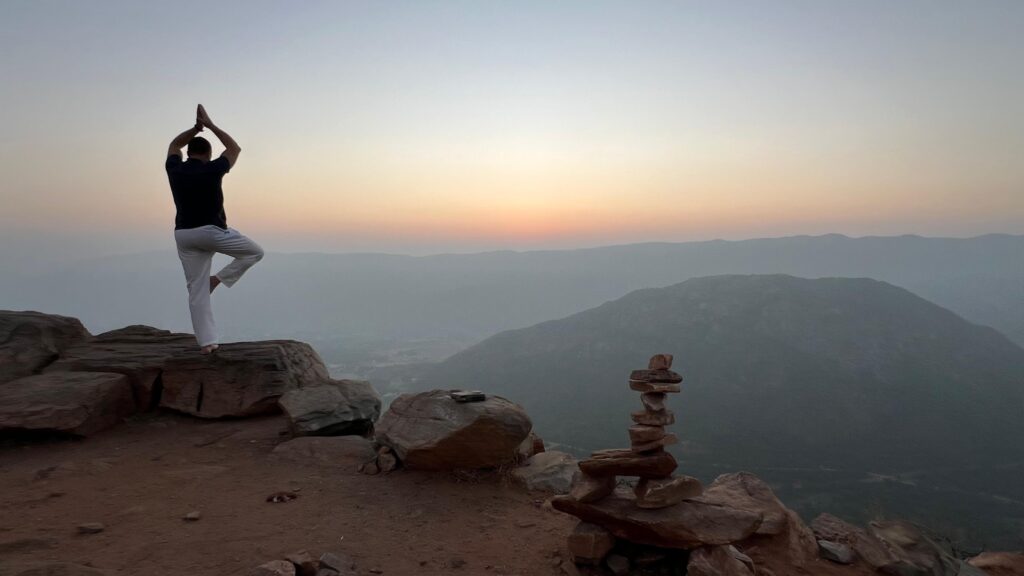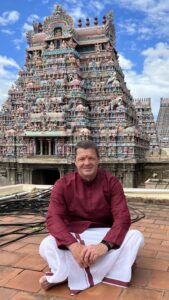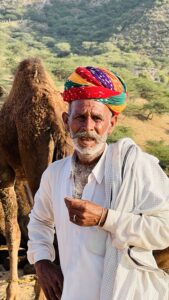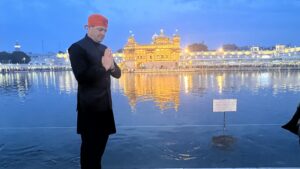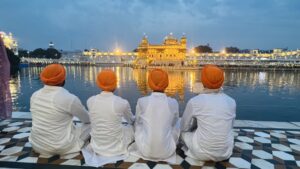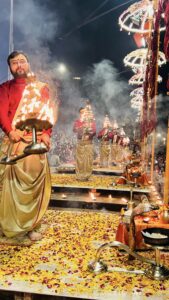An aviation man through and through. An entrepreneur but also a traveller and observer in the early morning of mighty India, a complex subcontinent of superlatives, ambitions, challenges and deep self-reflection. Seemingly a mutual love and a great adventure. A personal conversation with Pieter Elbers.
By Tijn Kramer
Although our compatriot naturally starts by talking about his profession, or rather his mission, aviation is only a side issue in this interview. Strange when it comes to Pieter Elbers, former KLM CEO and now CEO of IndiGo, the fastest growing airline in the world. But no, this story is above all about India. Pieter Elbers’ India.
The first of September, you will have been CEO of IndiGo, based in Delhi, for three years. What have you learned?
Let me start with the professional side – I find that easier. I was given the opportunity to apply the lessons I learned at KLM over the past decades in a largely untapped market. When I became CEO of KLM in 2014, I drew up a plan to restore the company to health in time for its 100th anniversary. I then implemented that plan, along with the accompanying structure. I applied the same approach in India – but in a completely different context.
In what sense completely different?
The country is incredibly ambitious, I can see that and I experience it. If you channel your energy in the right way, you can make huge strides and generate tremendous momentum. That really appeals to me. In that sense, I haven’t learned anything completely new, but I have learned that you can achieve a lot very quickly here. At IndiGo in India, there is more holistic thinking and rapid decision-making.
What do you mean by holistic thinking?
Let me docus on aviation, I think the horizon is a bit longer here. Across the entire playing field, you have a whole range of buttons you can press to run the airline as well as possible. The discussion in Netherlands (and perhaps Europe) seems often rather single dimensional on environment or noise. Here aviation is an integral part of the development of the country with an holistic / broader view with many -balancing- components; eduction, mobilty (in this vast country), social cohension, jobs, economic progress, the entire economic-social and societal spectrum.
You came from the small country of the Netherlands and then you woke up in huge India.
Yes, I did, I actually got started right away. I was 52 at the time, so I had another ten to fifteen working years ahead of me. One of the criteria I looked at was that the job had to have a longer horizon. And I really wanted to be part of that country and interact with its people. Also I do believe in aviation as a force for good. With IndiGo we’re literally giving wings to the nation (our Purpose) and hence contributing to that in this massive country is very fulfulling and makes me proud.
And that became IndiGo in India, a completely different culture, also in the workplace.
I did try to be very open to that. The Netherlands is a country where people plan ahead a lot and well. That has many advantages. But it also has disadvantages. Because if things don’t work out, it’s often been for nothing. Here, it’s almost the opposite. A lot happens at the last minute. And that’s not always ideal. But it also has its advantages. It allows you to achieve a lot. I’ve learned a fantastic word here: ‘Jugaad’. It means ‘always find a solution’. And that’s true, there is a solution for everything. Things that would take forever to fix in other countries are often solved in no time here.
A new look at business?
Yes, there are many things that appeal to me about the step I’ve taken. But one of the things that definitely appeals to me is entrepreneurship. You can just do a lot of things and get started. It’s part of the strategy, of course, but that strategy is peppered with entrepreneurship. And in that, you look for how things can be done and what is possible. And where the opportunities and possibilities lie. So yes, that does make me feel at home here. In a context where you are constantly engaged in entrepreneurship, literally.
In the Netherlands, we have a ‘yes, but’ culture. Does that exist here?
No… But that doesn’t mean that everything happens exactly the way you want it to. I don’t believe that one way is necessarily completely right and the other completely wrong. The Dutch way isn’t entirely right and the Indian way isn’t entirely wrong. And vice versa, it’s not that the Netherlands is completely wrong. So ‘yes, but’ is one extreme, and here it’s ‘yes, then’. But that doesn’t mean that it happens exactly that way. It does require some follow-up to keep your finger on the pulse. But the whole mindset is: we’re going to do it, we’re going to arrange it, it’s going to happen. And that appeals to me enormously. If you want it to happen, you dare to take that risk. If you ask people here: are you going to take a high risk with a higher potential return or are you going to take a low risk with a low return, the majority will go for the high risk and the high return.
More guts?
Yes. And then we just give it a try. And then we do everything we can to make it happen. And if it doesn’t work out, it’s not seen as a failure. We are on a mission to propel IndiGo forward in the march of progress. It is also an integral part of a vision for the country. India is progressively taking it’s place on the world stage, alreay it has world’s largest population and by 2027 it’s expected to be world’s 3rd largest economy. Aviation is an intrinsic part of this.
But how do you experience it personally? India is the most populous country in the world with 121 recognised languages, very different landscapes, religions, cultures, food and traditions.
That’s certainly true. But there is, of course, a strong connecting factor. And that is the Indian identity. And within that Indian identity, there are a number of things that are considered universally important. Food is one such example. Every 50 kilometres, the language changes and the food changes. But the fact that it is important does not change. In South Indian cuisine, dosas are the culinary pride and joy, while here in Delhi and the north, you can always talk about Chole Bhature (simplified, dosas are rice and dal pancakes, and chole bhature are bread rolls with chickpea curry, ed.). Even if you don’t have an opinion about it, you can still see it as a conversation starter. That’s what makes it so much fun. All those universal values, besides food, the importance of family, the festivals. I see those universal values more as a starting point for conversation. I avoid making any judgements. I don’t have any judgements about religion either. I’m just as likely to visit a Sikh temple as a Hindu temple.

Have you studied religion in depth so that you can understand it better?
If you asked me to give a university lecture on it, I obviously couldn’t. But if you ask me to outline what happens and why things happen the way they do, then I think I can. Every time I’m somewhere, I try to understand more about it and pick out things, elements that I can even use for myself. An open mind, smile and genuine interest brings you a long way.
How does that affect you personally?
Recently, I was with our team in Amritsar, where the largest Sikh temple is located. Early in the morning, I went back with my HR manager, who is Sikh, and another colleague. At five o’clock in the morning, you sit there by the water, away from someone explaining the temple or how it was built. You just sit there and let it all sink in in silence. I find it very difficult to describe exactly what it does to you, but it does touch you.
In January, I also went to the Maha Kumbh Mela (Hindu festival, ed.) in Prayagraj. This year was the largest edition, an event that only takes place once every 144 years. Around 400 million people attended over the course of the month. I was there at the very beginning, when it was still relatively quiet – I thought there were ‘only’ four million people. Then, like everyone else, I went into the Ganges. A unique experience for me. During the night, as far as the eye can see, you see Indians sleeping in tents or just on straw. At morning dawn to took the holy dip in the water. I posted a message later about it: ‘I found peace in the chaos’. That is what it was for me.
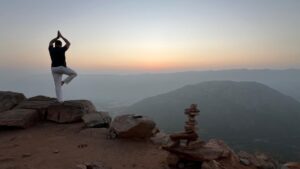 You ask me what kind of peace that is; I find it difficult to describe. But the best I can say is that ‘it makes me realise that there is more‘. I find it difficult to put into words what that ‘more’ is exactly. Still, it makes me realise that there is more. Especially when you are in places like that, which for me is always in the early morning. At the foot of the Ganges, somewhere on a mountain, or in this case even with thousands and thousands of people in the water – and you light a candle and let flowers float away. That feeling of ‘there is more’.
You ask me what kind of peace that is; I find it difficult to describe. But the best I can say is that ‘it makes me realise that there is more‘. I find it difficult to put into words what that ‘more’ is exactly. Still, it makes me realise that there is more. Especially when you are in places like that, which for me is always in the early morning. At the foot of the Ganges, somewhere on a mountain, or in this case even with thousands and thousands of people in the water – and you light a candle and let flowers float away. That feeling of ‘there is more’.
Far away from the glamour world of aviation…
I find it an incredibly enriching experience. And truly India too. Everything and everyone side by side, mixed together, with each other. Many faces. Wherever you are. You can be in a luxury hotel, but if you take three steps outside, it’s less beautiful, yet hugely fascinating. With that, but tolerance or acceptance is deeply rooted here. It means that I never feel unsafe, uncomfortable or like an outsider. I do look different, but with a few words of Hindi and a few simple gestures, everyone opens their heart. I had countless beautifull interactions with people in different walks of life.
So making an effort pays off…
Yes, we in Europe at times we can are of course very generalising. You are brought up in a certain context and culture, and you assume that this is the best way. Societies perhaps are also more uniform and less diverse. But in India, there are countless paths and ways. So yes, if you leave your prejudices and perhaps even your judgements behind and go in with an open mind, you get so much in return. Everyone knows what’s wrong with this country. You don’t have to explain it to them, they know it themselves. So they’re not waiting for me to come and tell them. If you take a step back and realise that you have a country with one and a half billion people… it doesn’t make much sense to look at the challenges of mobility, healthcare, sustainability and education through Dutch eyes. An incredible amount of work is being done to solve all these issues. But the scale of the country and its intensity mean that you sometimes arrive at different solutions or make different choices.
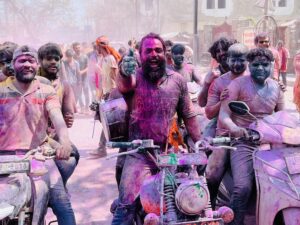
You shouldn’t come here with your Eurocentric perspective and Dutch finger-wagging.
You won’t get very far with a Dutch finger-wagging attitude, but the European approach isn’t really appropriate either.
Tourist India mainly revolves around the Golden Triangle and Goa. IndiGo flies to 92 destinations and you have visited more than 40 of them yourself. You are our expert.
One of the sayings here is: ‘You need nine lives to see and understand India‘. Understand it even more, I think. I don’t necessarily have one specific favourite, because India is so incredibly diverse. If you want to experience the backdrop of the Himalayas and the origins of the Ganges, then head to the area around Rishikesh. Varanasi gives such a profound insight into the culture. If you prefer palaces, then Rajasthan is the place to be, with cities such as Jaipur and Udaipur. I went to Leh with my son in the summer, just the two of us. It was fantastic! In the east, Bhubaneswar is highly recommended, and then of course there’s South India, which is very different in terms of culture, with all those colourful, stepped temples, such as in Madurai and Thiruvananthapuram. (see also the top 10 travel tips).
Nowadays, travellers are looking for authentic experiences. Are there plenty of those?
There are loads. The great thing is that, because flying is so affordable, you can travel from one place to another quite easily. And the airports are generally very close to the cities, so you can quickly get into town to do what you want to do. What I would strongly advise visitors to do is to avoid being dragged from monument to monument . It’s by walking through a market, sitting outside on a terrace or just observing local life that you get a much better and deeper sense of what life here is really like. India can be quite intense, I completely understand that, but it’s worth it.
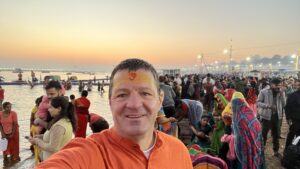 In the Netherlands, there are so many clichés that people are almost afraid of it.
In the Netherlands, there are so many clichés that people are almost afraid of it.
Go and discover and experience India for yourself. It is definitely accessible. You just need to make sure you are well prepared or outsource the organisation. So, either book an organised trip or arrange it yourself if you are an experienced traveller. Both options are actually quite easy to do.
Nevertheless, tourism to India, with around 10 million foreign visitors annually, is still relatively limited. Is it a sleeping giant?
More tourists visit Dubai than the whole of India, even though India has 42 World Heritage Sites and Dubai has none. The marketing and positioning do not seem to be attracting the number of tourists that could be possible. So the potential is enormous. The government’s promotion of India as a tourist destination, with its latest campaign ‘Incredible India’ already some time ago, has virtually come to a standstill. It has been left to the private sector. This is also because there is a lot of domestic tourism, which is exploding. That happens automatically, as it were. There is talk of reviving it, but it’s not there yet. I am confident it will come again.
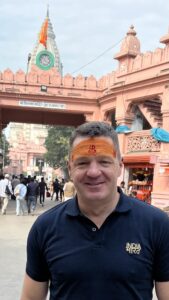
As the CEO of an airline with a clear ambition to become a global leader, do you see a role for yourself in this?
Yes, definitely. It’s not unique to India, of course. I just mentioned Dubai, where Emirates is an integral part of the whole ‘Dubai Inc.’ positioning. So I definitely see a role for airlines, and therefore also for us. The product we offer is also very well suited to this. It is Indian, but at the same time easily accessible for our non-Indian customers. What we also want to do, of course, is to get people here. We’ve only just started in Europe, but look at Singapore. We used to have three destinations from India to Singapore, and now we have nine. I think the whole network we’re building will help enormously. We’re also keen to work with the government to discuss how we can breathe new life into it.
Will that change in India if lots of tourists come?
I think that in the balance between domestic and foreign visitors, domestic tourism is many times greater. However, foreign tourists are very welcome for local economies, they generally spend more. Certainly in India, which is super price-competitive, tourists are welcome ‘spenders’ when it comes to hotels, transport, restaurants and souvenir shops.
India also has its own very unique tourist attractions, next to temples, palaces and nature. Travelling to festivals is also very popular here. Every year since I am here, I celebrate Holi (a religious festival celebrating the victory of good over evil, known for the use of coloured powder, ed.). It’s such an explosion of colours and energy! Weddings are also very important here. Recently, I was in Jaipur with my wife and two guests. There was a beautiful couple taking photos by the water. And then we were asked if we wanted to come to their wedding that evening. That would never happen anywhere else in the world, of course.
India is also undergoing rapid innovation and economic growth. Where is India headed? Where will it be in ten years?
Economic growth and innovation is indeed It‘s happening very quickly. Innovations such as facial recognition and mobile payments – you’re absolutely right about IT. Hyderabad and certainly Bengaluru have become IT capitals. It’s deeply rooted India, of course, but it’s taking on a very cosmopolitan character. Some visitors find that beautiful and interesting to see, and that may make it more accessible to some. For others, it may be less attractive because it threatens to lose some of its original character. But I actually think it increases the opportunities. It allows you to see and experience combinations of the so many different faces and greatly increases your tourist opportunities.
You can see the first mega shopping malls springing up on the outskirts of the cities. The ‘suburb’ of Delhi, Gurugram, where your office is located, is a modern city.
‘I believe there are 5 million people living in Gurugram. A New Zealander recently said to me: “The entire population of my country lives here in this suburb.” And it’s all high-rise buildings, shopping malls, large offices…
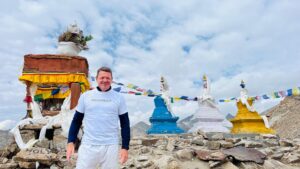
But that could have been a modern Asian city, like Singapore. Yet that image is still far from reality in the rest of the world. That it is also India 2.0.
‘No, you’re absolutely right about that. India has so many paradoxes and different images. India is sometimes not very good at “selling itself”. But the domestic challenge and opportunity is, of course, is already so great. Why spend resources on image building for foreign countries when there are so many other issues that require attention? But I believe it will come naturally, also because many international companies are establishing themselves here.
Looking at the old India and the new India, I would like to share a quote with you, from the writer Arundhati Roy: ‘India lives in several centuries at the same time.’
That’s absolutely true. You see high-tech alongside sacred cows, shopping malls next to temples. Another favourite is from Reymond Page: ‘Waking up in India is like waking up to life itself. I definitely feel that when I’m out and about early in the morning, somewhere outside Delhi, at a market or by a river. Every day here is intense, surprising, full of life. And it’s a real privilege to be able to experience that. I have embraced and India has warmly embraced me.
It was quite the story three years ago leaving KLM…
KLM has been fantastic for me. I started out loading planes and ended up as CEO. I have worked with incredibly nice people and learned from good managers. I put a lot of energy into it, but I also got a lot in return. At the age of 32, I was already living in Japan for KLM. I have seen many countries and gained a lot of experience, for which I am incredibly grateful. 
And then IndiGo knocks…
You’ve been doing something in one company for thirty years, and then that chapter ends. And then… there’s a ‘totally new life out there‘. You take everything you’ve learned with you, but you also leave some baggage behind. That creates space to recharge your batteries, develop yourself and move forward. And then India suddenly becomes your new home. It’s a country that opens its arms to you. I see that almost as a privilege.
Everything I can see here, everything I can experience, where I can travel; the people I meet, the experiences I have – these are important both professionally and personally. A ‘simple boy from Schiedam’ gets to meet the Prime Minister of India, a world leader. I feel privileged to be able to experience and do all this, and to share it with my children and my wife. It has enriched me enormously and broadened my perspective. I may sound a bit like an old man now, but when you look back on everything you’ve done and been able to do… I firmly believe that you have to get the most out of life, out of what you’ve been given. And if you’re healthy, and your children and your wife are healthy, then you can truly say: ‘God has been kind.'”
END TEXT
EXTRA:
Pieter Elbers’ top 11 travel tips for India
‘Almost impossible,’ replies Elbers. That would be unfair to many other beautiful locations I have visited, such as Udaipur, Trivandrum, Jaisalmer, Jaipur, Goa, Dharamshala, Gwalior, and so on… And these are the ones I know of… there are still many, many more I don’t even know about…I have nevertheless made an attempt with a mix of festivals, cities, religious and ‘must-do experiences’.
1 Celebrate Holi in Vrindavan & Mathura
- Wander through Old Delhi and enjoy street food
- Wake up in Taj Mahal Palace Mumbai and see The Gateway of India
- Kumbh Mela in Prayagraj (*)
- Varanasi, unmatched in colour, people, intensity and experience Aarti
- The world’s highest road in (spiritual) Leh
- South India temple beauty in Tiruchirappalli (Trichy)
- The Golden Temple in Amritsar
- Camel Fair in Pushkar
- Rishikesh, yoga capital, fresh air and deeply religious
- Taj Mahal in Agra, simply because it cannot be missed!
(*) The Kumbh Mela in Prayagray was in January 2025, the next one will be in 144 years, but every few years there are smaller versions of the Kumbh.
(photos personal archive Pieter Elbers)

